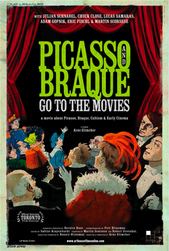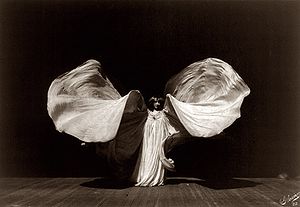 Picasso and Braque Go To The Movies, Arne Glimcher’s new film, isn’t going to break any box office records, that’s for sure. I saw it over the weekend, and while I enjoyed much of it, the film felt padded to me — even though it clocks in at just 62 minutes.
Picasso and Braque Go To The Movies, Arne Glimcher’s new film, isn’t going to break any box office records, that’s for sure. I saw it over the weekend, and while I enjoyed much of it, the film felt padded to me — even though it clocks in at just 62 minutes.
The question here, though, is whether it will appeal to art-lovers. I think it’s worth the hour. And I say that after seeing the movie, in a hole-in-the-wall cinema in the Village (with a seating capacity of, oh, say 35? I should have counted but didn’t), with a screen no bigger than the largest wide-screen TVs. (And that says something about the appetite for art films.)
The film sets out to show how the creation of movies (especially those of the Lumiere Brothers), the invention of aviation, and other technological developments at the start of the 20th century (not African art or Iberian art) inspired Picasso and Braque to invent Cubism. It also throws in the Serpentine Dance of Loie Fuller (below), which is more convincing than it sounds — and is also gorgeous. Plus the use of fans.
 Those elements work, and they fun to watch. Martin Scorsese, as narrator, bothered some critics, but not me. The scholars, including Bernice Rose, Natasha Staller, and John Richardson, were very articulate and enlightening — though their names are left out of the reviews. It was the interviews with artists that drag down the film. Julian Schnabel and Eric Fischl are particularly inarticulate, but Chuck Close was hardly much better. Only the late Coosje van Bruggen aquitted herself well.
Those elements work, and they fun to watch. Martin Scorsese, as narrator, bothered some critics, but not me. The scholars, including Bernice Rose, Natasha Staller, and John Richardson, were very articulate and enlightening — though their names are left out of the reviews. It was the interviews with artists that drag down the film. Julian Schnabel and Eric Fischl are particularly inarticulate, but Chuck Close was hardly much better. Only the late Coosje van Bruggen aquitted herself well.
I say this not to be mean, but to raise a general point about visual-arts movies: too often, inho, they rely on long, rambling interviews with artists who paint, or draw, or do whatever their thing is, far better than they explicate.
Before writing this post, I checked the movie’s ratings on my favorite review-aggregation site, MetaCritic.com (because it links to so many reviews). It gave the movie a score of 50, out of 100, based on just six reviews (it’s usually 20 or more). The scores ranged from 25 (from The New York Post) to 100 (from the Christian Science Monitor). No readers — whose ratings are listed separately, and are often more in tune with my likes and dislikes — have weighed in at this writing.
Rotten Tomatoes, btw, begs to differ.
Good for Glimcher for making this film, but I wish he hadn’t drawn it out with interviews that make it worse, not better.
Photo Credit: Frederick Glasier (bottom)
